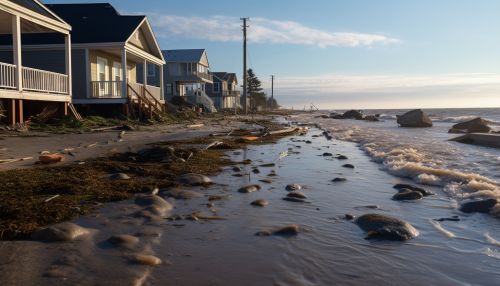Sea Level Rise and Coastal Vulnerability
Introduction
Sea level rise refers to the long-term increase in the average level of the ocean relative to the land. This phenomenon is primarily driven by two factors: thermal expansion of sea water as it warms, and the addition of water into the ocean basins from the melting of land-based ice such as glaciers and ice sheets. The rate of sea level rise has been accelerating in recent decades, posing a significant threat to coastal communities and ecosystems worldwide.


Causes of Sea Level Rise
There are several key factors contributing to sea level rise, including thermal expansion, melting of glaciers and ice caps, and loss of ice from the Greenland and Antarctic ice sheets.
Thermal Expansion
As the temperature of the ocean increases, the water expands. This thermal expansion accounts for about half of the observed sea level rise to date and is expected to be a significant contributor to future sea level rise.
Melting of Glaciers and Ice Caps
Glaciers and ice caps are large bodies of ice that remain frozen from year to year. As the Earth's climate warms, these ice bodies are melting at an increasing rate, adding more water to the oceans and causing sea levels to rise.
Loss of Ice from Greenland and Antarctic Ice Sheets
The ice sheets of Greenland and Antarctica contain the largest amount of fresh water on Earth. As temperatures increase, these ice sheets are losing mass, both through melting at their surfaces and through the discharge of ice into the ocean from glaciers that drain the ice sheets. This loss of ice is contributing significantly to sea level rise.
Impacts of Sea Level Rise
Sea level rise has a range of impacts, particularly on coastal systems. These impacts can be broadly categorized into physical impacts, ecological impacts, and socio-economic impacts.
Physical Impacts
Physical impacts of sea level rise include increased flooding and erosion. As sea levels rise, flooding events that were once considered rare are becoming more frequent and severe. Coastal erosion is also being exacerbated by sea level rise, leading to the loss of land and damage to coastal infrastructure.
Ecological Impacts
Sea level rise can have significant impacts on coastal ecosystems. For example, it can lead to the loss of coastal wetlands, which provide important habitat for many species and offer natural protection against storm surges. Sea level rise can also lead to the inundation of low-lying islands, threatening the unique ecosystems that they support.
Socio-Economic Impacts
The socio-economic impacts of sea level rise are wide-ranging and can be severe. These impacts include damage to and loss of property and infrastructure, displacement of people, loss of agricultural land, impacts on tourism, and increased costs for coastal defense.
Coastal Vulnerability
Coastal vulnerability refers to the susceptibility of a coastal area to the impacts of sea level rise. Factors that influence coastal vulnerability include the physical characteristics of the coast, the presence and condition of coastal defenses, and the socio-economic characteristics of the coastal population.
Physical Characteristics
The physical characteristics of a coast, such as its elevation, slope, and geology, can greatly influence its vulnerability to sea level rise. For example, low-lying, flat coasts are more susceptible to flooding and erosion than higher, steeper coasts.
Coastal Defenses
The presence and condition of coastal defenses, such as seawalls, dikes, and beach nourishment, can also influence a coast's vulnerability to sea level rise. However, these defenses can be costly to build and maintain, and they can have negative impacts on coastal ecosystems.
Socio-Economic Characteristics
The socio-economic characteristics of a coastal population, such as its size, wealth, and ability to adapt, can also influence the vulnerability of a coast to sea level rise. For example, densely populated, poor communities may be more vulnerable to the impacts of sea level rise than less populated, wealthier communities.
Mitigation and Adaptation Strategies
There are two main strategies for dealing with sea level rise: mitigation and adaptation. Mitigation involves reducing the rate of sea level rise, primarily through the reduction of greenhouse gas emissions. Adaptation involves adjusting to the changes brought about by sea level rise.
Mitigation
Mitigation strategies include reducing greenhouse gas emissions, which can slow the rate of global warming and thus the rate of sea level rise. This can be achieved through a variety of means, including increasing energy efficiency, switching to renewable energy sources, and implementing carbon capture and storage technologies.
Adaptation
Adaptation strategies include building or enhancing coastal defenses, implementing land use planning and zoning regulations to limit development in vulnerable areas, and relocating people and infrastructure away from vulnerable coasts. It also includes restoring and protecting natural coastal ecosystems, which can provide natural defenses against sea level rise.
